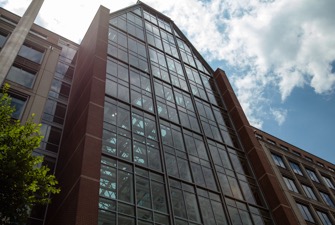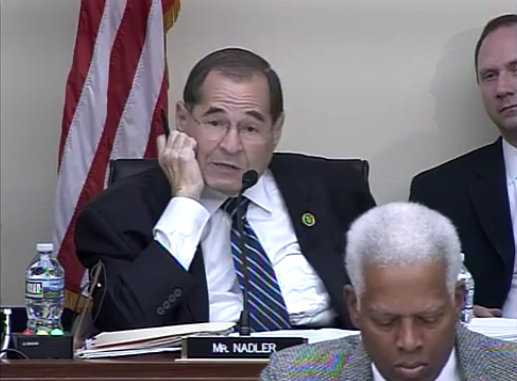Does the USPTO paying for shared services violate the AIA?
 During the August 20, 2015, Patent Public Advisory Committee (PPAC) meeting, USPTO Director Michelle Lee first announced what was known as the shared services initiative. Today, “shared services” has been re-branded “enterprise services,” but the initiative remains the same.
During the August 20, 2015, Patent Public Advisory Committee (PPAC) meeting, USPTO Director Michelle Lee first announced what was known as the shared services initiative. Today, “shared services” has been re-branded “enterprise services,” but the initiative remains the same.
In 2015, Lee explained the shared services initiative by saying that agencies falling under the Department of Commerce would utilize shared services for human resources, information technology and procurement functions. The fear then, however, was that the USPTO’s user fees would be used to pay for the IT and other needs of other Commerce agencies when those funds are supposed to be used only for the operation of the USPTO. See AIPLA letter to Secretary Pritzker and Under Secretary Lee. That is precisely what is happening now, only worse.
The new reality today is that the USPTO is paying for shared services that are simply not shared. According to Frank Murphy, Acting Chief Financial Officer, who recently spoke at a PPAC public meeting, the USPTO will not be using the services because the USPTO systems are superior to the shared services being created. The USPTO is still, nonetheless, paying for the creation of these services.
SCOTUS asks Director Lee to respond to SCOTUS cert petition
At the end of February, the United States Supreme Court requested a response from Michelle K. Lee, Director of the United States Patent and Trademark Office (USPTO), related to the petition for writ of certiorari filed by Oil States Energy Services, LLC, Petitioner, against Greene’s Energy Group, LLC, et. al. The dispute is between the parties to an inter partes review (IPR) proceeding conducted by the Patent Trial and Appeal Board (PTAB).
There are three questions presented by Oil States in the petition for writ of certiorari:
- Whether inter partes review – an adversarial process used by the Patent and Trademark Office (PTO) to analyze the validity of existing patents – violates the Constitution by extinguishing private property rights through a non-Article III forum without a jury.
- Whether the amendment process implemented by the PTO in inter partes review conflicts with the Court’s decision in Cuozzo Speed Technologies, LLC v. Lee, 136 S.Ct. 2131 (2016), and congressional direction.
- Whether the “broadest reasonable interpretation” of patent claims – upheld in Cuozzo for use in inter partes review – requires the application of traditional claim construction principles, including disclaimer by disparagement of prior art and reading claims in light of the patent’s specification.
03.22.17 | Patent Issues, posts, Supreme Court Cases | Gene Quinn
Hearing on Examiner Fraud Leaves No Resolution
 In mid-September, the House Judiciary Committee held what seemed like it was going to be an oversight hearing to address the allegations of timekeeping fraud by patent examiners made in the Inspector General’s recent report. Prepared statements released in advance of the hearing talked tough, but that was pretty much it. Insofar as getting to the root of the problems identified in the IG report the hearing turned out to be a big, fat nothing.
In mid-September, the House Judiciary Committee held what seemed like it was going to be an oversight hearing to address the allegations of timekeeping fraud by patent examiners made in the Inspector General’s recent report. Prepared statements released in advance of the hearing talked tough, but that was pretty much it. Insofar as getting to the root of the problems identified in the IG report the hearing turned out to be a big, fat nothing.
Congressman Jerrold Nadler (D-NY) (pictured left at the hearing) defended the Office in his prepared remarks, explaining that there were flaws with the methodology of the IG study, which make the conclusions unreliable. For example, it is entirely possible that patent examiners were indeed working while they were not logged into the Patent Office computer systems. After all, examination is a job that requires a lot of reading and contemplation, much of which might occur without being logged into the server. Of course, that, at best, means there is no way to know whether patent examiners are working or not, which is why the IG report recommended the sensible step of requiring patent examiners to log into the Office computer systems whenever they are working.
10.11.16 | Congress, Patent Issues, USPTO | Gene Quinn
USPTO Director Lee testifies before House Judiciary Committee
 On the afternoon of Tuesday, September 13th, the intellectual property subcommittee of the U.S. House of Representatives Judiciary Committee convened for a hearing on oversight of practices and procedures at the U.S. Patent and Trademark Office. The day’s sole panelist was USPTO director Michelle K. Lee. The day’s discussion focused on recent reports from federal governmental agencies regarding issues at the USPTO surrounding patent litigation as well as time and attendance abuses among USPTO examiners.
On the afternoon of Tuesday, September 13th, the intellectual property subcommittee of the U.S. House of Representatives Judiciary Committee convened for a hearing on oversight of practices and procedures at the U.S. Patent and Trademark Office. The day’s sole panelist was USPTO director Michelle K. Lee. The day’s discussion focused on recent reports from federal governmental agencies regarding issues at the USPTO surrounding patent litigation as well as time and attendance abuses among USPTO examiners.
A press release posted in advance of the hearing contained statements from both House Judiciary Committee chairman Bob Goodlatte (R-VA) and Courts, Intellectual Property, and the Internet subcommittee chairman Darrell Issa (R-CA) provided a good indication of the direction the hearing would take. Both statements reflected a wariness regarding timesheet abuses among USPTO employees. “The amount of wasted man-hours that could have been spent reducing the patent backlog is astounding, not to mention the millions of taxpayer dollars that were wasted paying USPTO employees for work they were not doing,” Goodlatte’s statement read. Issa added, “If the PTO can’t even guarantee sufficient oversight of its employees timecards, how can we be assured patent examiners aren’t just rubberstamping ideas without oversight as well?”
The concerns of both Congressmen stem from an examiner time and attendance report issued August 31st by the Office of the Inspector General (OIG) within the Department of Commerce. The Commerce Department’s OIG found 288,000 unsupported hours of work claimed by examiners over a 15-month period, which was equated to more than $18.3 million in potential waste. The OIG report also found multiple weak points in USPTO policy which limits the agency’s ability to detect fraud, including no requirement for teleworking examiners to log into computers during workdays as well as no requirement for workers with average or high performance ratings to provide supervisors with work schedules.
The methodology used during the OIG’s study on time and attendance abuse was also questioned by Congressman Jerrold Nadler (D-NY). Nadler’s prepared remarks noted that the unsupported work hours identified in the OIG’s report amounted to less than 2 percent of all hours worked by examiners during the 15-month period of the study. “In fact, the IG acknowledges that after the USPTO instituted certain reforms to its telework policy, six months into the study, the percentage of unsupported hours dropped to just 1.6%, an efficiency rate that most employers would boast about,” Nadler’s prepared remarks stated. “But, the IG buried this fact in a footnote deep in the report.”
“My team and I do not tolerate time and attendance abuse,” Lee told the subcommittee. While she did note that the USPTO had taken disciplinary actions against examiners that have abused time and attendance reports, such actions ranging from counseling to expulsion and repayment for hours not worked, she added that there was evidence that instances of time and attendance abuse were not widespread. She cited a report on the USPTO’s telework program issued by the National Academy of Public Administration (NAPA) in July 2015. The report found that “It would appear to be unlikely that [time and attendance] abuse is widespread or unique to teleworkers, and it does not appear to reflect the actions of the workforce as a whole.”
09.19.16 | Patent Issues, USPTO | Gene Quinn
On the Record with USPTO Director Michelle Lee
 On Wednesday, January 20, 2016, I had the opportunity to go on the record with Michelle Lee, who is Under Secretary of Commerce for Intellectual Property and Director of the United States Patent and Trademark Office (USPTO).
On Wednesday, January 20, 2016, I had the opportunity to go on the record with Michelle Lee, who is Under Secretary of Commerce for Intellectual Property and Director of the United States Patent and Trademark Office (USPTO).
During our 30-minute conversation, we discussed a wide range of topics, including the release of the Commerce Department’s Copyright White Paper, which among other things recommends expanding eligibility for statutory damages in certain copyright infringement actions. We also discussed Lee’s recent visit to the Consumer Electronics Show (CES), the power outage that brought down USPTO electronic filing systems, the Office’s patent quality initiative, the new patent classification system, the Patent Trial and Appeal Board (PTAB), and more. For the full transcript of our interview, please see An Exclusive Interview with Michelle Lee.
What follows are the highlights of our interview.
Right before the holidays, on December 22, 2015, the USPTO suffered a major power failure. Everything is back to normal now, but I wanted to ask Director Lee about where we stand and if she could confirm no data had been lost. Director Lee explained things are indeed back to normal and no data was compromised.
LEE: Yes. So we are fully up and running as before, and we have been for a while now. No data was lost, and it was really an unprecedented outage of our online systems caused by an electrical failure to the data center that was owned and operated by contractors. It was not a failure of our IT systems or the result of foul play. And I have to say, Gene, the dedicated team of USPTO employees mobilized and immediately stabilized and restored the systems. They worked around the clock when the outage occurred, during the holidays, to restore customer service and we were, again, fully operational within a matter of days. That’s a real testament to the incredible hard work, the incredible dedication of so many employees here at the PTO working very hard and really wanting to do what’s in the best interest of the stakeholders to get those services up and running. So everything is up and running as normal. We did not lose data. And we’re conducting careful forensics and we’re looking to incorporate what we learn into further improvements to our system. Actually, not our systems, but the third-party systems that feed our systems. So it’s not a lost opportunity, but we’re glad to have it up and running, and I give all the kudos to the team.
02.2.16 | Patent Issues, posts, USPTO | Gene Quinn


No Comments
03.27.17 | posts | Gene Quinn